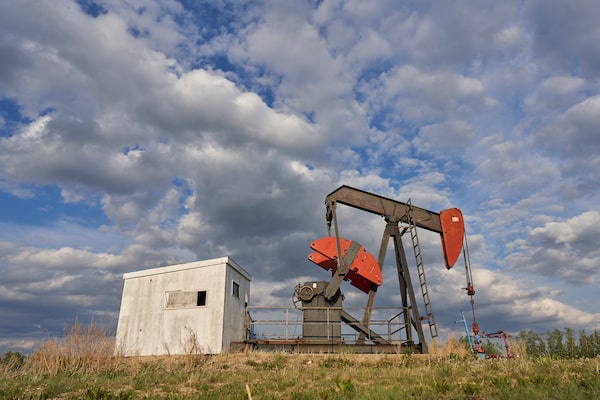
An orphaned well sits in a field near Red Deer, Alta. on May 24, 2023.GEOFF ROBINS/Getty Images
Alberta’s oil and gas sector spent more than $1.2-billion on cleaning up wells in 2022, reducing the total number of inactive wells by about 10 per cent, according to the province’s energy regulator.
About half of that, $696-million, was spent directly by companies that operate wells. The rest came from the Orphan Well Association, which cleans up sites that no longer have an owner, and a provincial site rehabilitation program funded by a billion-dollar federal government grant.
The numbers were released Wednesday in the Alberta Energy Regulator’s 2022 Liability Management Performance Report. It’s the first time the AER has published an analysis of how the conventional oil and gas sector is managing the closing and cleanup of its wells, pipelines and other facilities across the province.
The idea of the report is to improve the transparency of the sector’s massive portfolio of liabilities. It will also help develop performance baselines after an overhaul of the province’s reclamation rules in 2022, including a new, annual spending requirement for cleanup work.
The AER set that requirement at $422-million for the first year of the program, which the industry exceeded by 65 per cent. For 2023 and 2024, it has been raised to $700-million. Adjusted each year, it’s based on various factors such as commodity prices, market conditions and the cost of cleanup.
But an expert on the subject wasn’t impressed. Martin Olszynski, an associate law professor at the University of Calgary, said the amounts aren’t enough to tackle a huge problem and the AER report is little more than a “sales pitch” to Albertans.
Oil and gas companies have raked in record profits over the past two years. But midyear economic swings won’t change the spending requirement, said Anita Lewis, the regulator’s senior adviser for liability strategy.
“If we shifted midyear, the difficulty is the planning for industry to be able to gain access to those sites, but also actually having a plan to do the closure work,” Ms. Lewis said in an interview. “They need that preplanning period to be able to effectively do the closure work.”
Oil and gas well cleanup is driven by more than regulatory requirements, said David Hardie, the AER’s director of liability management.
“Financial institutions have recognized that having inactive inventory is a challenge for the sustainability of companies. So the financial institutions’ attention to that will warrant more companies spending more money,” Mr. Hardie said.
Companies have also recognized that cleanup work can be collaborative, he said, which helps speed up closing work and reduces costs.
“It’s good business for them to work together to remove inactive infrastructure from the landscape.”
But the analysis fails to show the true scale of oil and gas liabilities, said Mr. Olszynski at the University of Calgary. He recently co-published a study that found that Alberta’s end-of-life rules and reclamation system must undergo an independent public inquiry to avoid financial and environmental catastrophe.
“It’s another sales pitch, and I think at this point Albertans don’t want or need or deserve another sales pitch about the industry from the regulator. They deserve some transparency and some forthrightness and some accountability,” Mr. Olszynski said in an interview.
The money that industry spent on cleanup in 2022 is unimpressive considering it’s a problem that has been chronically underfunded for decades, he said, and $700-million for the next two years is far too low if the industry is going to make any kind of dent in liabilities.
He added that the AER should consider wielding a harsher regulatory stick to force site reclamation.
“We’ve been doing the carrot approach for 20 years, and it doesn’t work,” he said. “We need what jurisdictions that have functioning liability regimes have – we need timelines on closure, and we need security being put upfront for these things to ensure that that money is there when it’s required.”
Alberta’s inactive well count currently stands at 83,000, down from 91,000 in 2021, according to the report. Most are owned by companies in good financial health, but operators deemed to have high financial distress hold 8 per cent of the total portfolio, according to the AER’s planning manager, Chad Newton.
The vast majority of companies complied with the mandatory cleanup spending introduced in 2022. Of the 10 per cent of operators who didn’t, most were smaller outfits, he said.
Companies that don’t meet the mandatory spending are subject to various penalties under AER rules. That includes having to pay more security or, as is the case with the 51 companies that broke the rules in 2022, being placed on a list that halts the processing of any of their applications to the AER.
Laurie Pushor, the AER’s president and chief executive officer, said in a statement that the report is a “robust and clear indication that the industry is improving in the cleanup of oil and gas wells, pipelines, and facilities.”
However, he added, “continued focus and effort is required to ensure the sustained downward trend in reducing inactive well count in the future.”
Alberta Environment Minister Rebecca Schulz said in a statement that two new reclamation pilot projects will begin in the next few weeks.
“As this moves forward, we will continue looking at new ways to speed up closure and cleanup work while maintaining world-class environmental standards, and at ways to reclaim sites as quickly, safely and effectively as possible,” Ms. Schulz said.